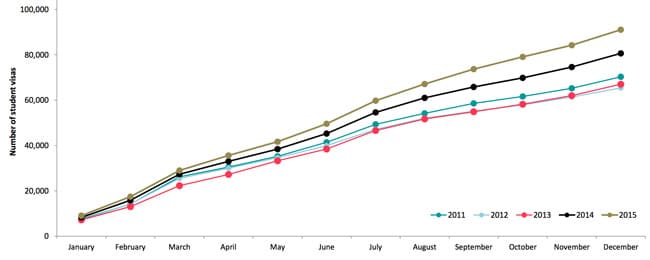Full-year data confirms strong growth for New Zealand in 2015
The latest data release from Education New Zealand (ENZ) confirms another year of strong growth for the country’s international student numbers.
ENZ’s full-year Student Visa Dashboard for 2015 reports a total of 91,062 student visas approved for the year. This represents a 13% year-over-year increase in total student visa approvals, or 10,407 more visas issued than in 2014. Nearly half of that growth (45%) is attributed to first-time student visas (that is, to commencements), with the balance arising from 5,754 additional student visa renewals issued by New Zealand in 2015.
As always, there is a gap between student visa data and actual enrolment numbers as there may be a lag of some months between the time the visa is received and the student’s actual attendance. Further, students enrolled in courses of less than three months do not require a study visa. This means the visa data generally understates enrolment in any Private Training Establishments (PTEs), including language schools, offering shorter-term programming.
Even so, visa data is an important indicator of, and correlates closely to, actual enrolment and the full-year numbers for 2015 reveal that New Zealand continues the trend to strong growth that began in 2013.

Main growth drivers
China and India continue to be the engine of international enrolment growth in New Zealand. There were 15% more visas issued to Chinese students in 2015 than the year before, and 20% more to Indian students. In absolute terms, this translates into nearly 4,000 more visas to Chinese students in 2015, and just over 3,500 more for Indian students.
Interestingly, much of the growth in visas to Indian students arises from continuing students who received a visa renewal in 2015. Of the 3,559 total visas issued to Indian students during the year, only 580 were for first-time students. The enrolment base for China was a little more balanced with 1,310 of the 3,942 visas issued to Chinese students (or about a third of the total) associated with first-time arrivals in New Zealand.
No other national group comes even close in terms of contribution to real enrolment growth, but several other sending markets registered significant increases in terms of total visas issues for 2015, including the Philippines (85%, or 1,207 additional visas), the United States (30%, 656 additional visas), Brazil (23%, 357 additional visas), Sri Lanka (34%, 233 additional visas), and Colombia (28%, 208 additional visas).
International enrolment in New Zealand breaks down across several well-defined sectors. Roughly 40% of all foreign students are enrolled with Private Training Establishments (PTEs), including language schools. The next largest sector - universities - accounts for another 29%. Institutes of Technology and Polytechnics (ITPs) and schools round out the mix with roughly 15% of total enrolment each.
As the following chart reflects, PTEs and ITPs account for significant shares of New Zealand’s total enrolment growth since 2013, and have outpaced all other sectors during this period. 2015 growth is playing out a similar fashion, where the greatest year-over-year increases in total visas issued were booked by ITPs, PTEs, and universities, which were up 36% (1,924 additional visas), 9% (1,284), and 11% (934) for the year respectively.

Falling domestic enrolment
New Zealand’s progress in building its international enrolment in recent years looms even larger given the forecasts for domestic enrolment. Starting this year, the Ministry of Education projects the total numbers of domestic university students will decline every year until 2019. Driven by a shrinking pool of university-aged students, as well as a strong employment outlook in the New Zealand economy, the Ministry estimates a drop of 3,000 full-time students for 2016, 5,200 in 2017, and then another 1,900 in 2018. This works out to a reduction of roughly 10,000 full-time students over the three years, or about 7% of 2015’s domestic enrolment base, and could reduce revenues from student fees and public grants by more than NZ$120 million (US$80 million) per year. Universities New Zealand Director Chris Whelan, acknowledged the challenge in a recent interview with University World News, "We can't argue with the demographics. We know that the numbers of 17-year-olds coming out of the school system are dropping by about one to two percent a year, levelling off in 2019 and starting to reverse after that, but we are definitely in a very tight four-year period." For its part, the New Zealand government has indicated a willingness to boost research funding to universities as well as per-student subsidies in some fields of study to help counter the projected shortfall in university revenues. We might imagine as well that government stakeholders and institutions may continue to look to expanding international enrolments to offset some of the forecast declines in domestic student numbers.













